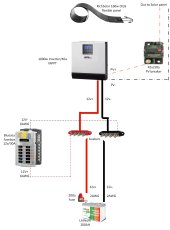drewniverse
New Member
- Joined
- Jan 8, 2022
- Messages
- 7
Hi guys, I have a 98 GMC Savana w/ Bubbletop. I took the plunge and purchased a ZOOMS 100AH, 160 watt CIGS flexpanel, MPP solar 1012LV-MS charge controller/inverter, 5 feet 6gauge red/black cables for battery to controller, 10 Gauge 10 Feet Cable Connect Solar Panel to Charge Controller, cable entry gland, , extension cable for 120v input/output.
Pretty sure I covered all the bases here. I'm wide open to suggestions.
I got the battery so far. I think I should have the panel by tomorrow.
Should I use inline ANL fuses in this setup?
I would like to add a 20amp Renogy Dc to DC charger with on/off switch so I can charge my house battery while driving after topping off the starter. How can I implement that into my new system without damaging it?
Thanks.
Pretty sure I covered all the bases here. I'm wide open to suggestions.
I got the battery so far. I think I should have the panel by tomorrow.
Should I use inline ANL fuses in this setup?
I would like to add a 20amp Renogy Dc to DC charger with on/off switch so I can charge my house battery while driving after topping off the starter. How can I implement that into my new system without damaging it?
Thanks.



